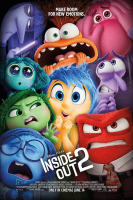Home Alone
The transition from the classic live-action film "Home Alone" to an animated version is a creative venture that piqued my curiosity. Revamping a beloved movie into a cartoon is no easy task, yet the animation medium offers a fresh lens with which it can be appreciated.
As I dived into this new representation, my initial thoughts were centered on how the filmmakers would manage to preserve the charm and spirit of the original while infusing it with the unique flair that animation allows. It turns out, the animated "Home Alone" brings a much-needed whimsical touch to the storyline, making the adventures of an 8-year-old left at home resonate even more with a new generation.
History: From Big Screen to Animated Frames
The original "Home Alone," released in 1990, became an iconic holiday favorite almost instantaneously. Its premise of a young boy inadvertently left behind while his family flies to France captivated audiences and critiqued the importance of family in a humorous manner. With a handful of sequels and spin-offs, its legacy was firmly established in pop culture.
Turning it into a cartoon seemed like a logical next step, allowing the creators to push the boundaries of an already exaggerated plot through colorful animation techniques. The history of the franchise gives the animated version the advantage of being grounded in a beloved narrative, yet leaves room for innovation and imaginative storytelling that animation uniquely allows.
Why It Is Interesting: Potential and Limitlessness of Animation
Animation removes restrictions inherent in live-action filmmaking. The freedom to exceed physical limitations opens the door to more outrageous and creative booby traps than ever, which is at the heart of what makes "Home Alone" entertaining. The exaggerated antics are even more comical when not confined by real-world physics.
Moreover, animation brings a visual vibrancy to the snow-cloaked Chicago suburbs setting, enhancing the magical allure of the Christmas holiday. It is fascinating to see how the streets and houses become part of Kevins' extended playground, depicted in kaleidoscope colors that live-action could only dream of achieving.
Character Development: Breathing New Life into Kevin
Kevin McCallister’s character is reimagined with playful dynamism through animation. It's like witnessing his persona being drawn out from a backdrop and actively participating in the chaos - all while maintaining the clever innocence that defines him.
The cartoon enriches his emotional depth through expressive animations that convey a range of feelings more intensely than a child actor might. Watching animated Kevin navigate his solitude amidst the animated shadows and echoes throughout his house imparts a vivid engagement with his rollercoaster of emotions.
Nostalgia: A Bridge Between Generations
For those of us who grew up with the original movie, the animation version is a nostalgic trip down a snow-laden memory lane. It revisits a simpler time when the thought of defeating dim-witted burglars with home-spun traps seemed like the ultimate adventure.
At the same time, it serves as a perfect medium for sharing a beloved story with a younger generation, offering a cultural and familial bridge. The animated portrayal ensures that the legacy of Kevin's thrilling adventures continues, visualized in a way today's children are increasingly familiar with, through animated storytelling.
Sound and Music: Melody Meets Animation
The transition to an animated world also shakes elements of the soundscape. Accompanying the visual immersion is a revamp of the original soundtrack, where classic themes are rendered in sync with the delightful bounce of animation.
This auditory experience enhances comedic timing and emotion, with over-the-top sound effects adding an extra layer of fun to Kevin's encounters and traps. It's a harmonious blend that meshes nostalgia with a modern animated twist, strengthening the story's appeal.
Visual Arts: Animation Style and its Merits
The illustrative style of the animated "Home Alone" highlights both creativity and continuity with its original. Characters are recrafted with vivid exaggeration, infusing them with both charm and vibrancy, vital aspects for a cartoon aimed at engaging a diverse audience.
The artistry extends to Kevin's constructed house of traps, where the clean lines and dynamic frames accentuate the imaginative machinations. This not only entertains but also invites viewers to momentarily suspend disbelief and enjoy the animated spectacle.
Comedy: Amplified Laughter through Animation
An inherent advantage of animation is the amplification of comedic elements. Exaggerated expressions, slapstick humor, and imaginative scenarios enhance the hilarity of Kevin's escapades and misadventures.
The burglars' antics lend themselves perfectly to animation, their exaggerated reactions providing comedic relief that keeps the audience engaged and laughing, reaffirming the timeless appeal of slapstick humor when done well.
Suspending Disbelief: Easier in Animation
Suspending disbelief becomes significantly easier with animation, which is crucial in a story dependent on implausible scenarios. The format embraces the unrealistic and the outrageous, encouraging viewers to join in on the fun without questioning the premise.
Instead of focusing on plot holes, audiences are led to appreciate the inventive ways animation utilizes improbability as an asset, transforming it into a narrative tool rather than a drawback.
Family Dynamic: Importance of Family Themes
At its core, "Home Alone" is a story about family, and the animated iteration maintains this central theme with warmth and humor. Amidst the chaos, the essence of familial connections is conveyed through endearing moments and heartfelt messages.
This aspect is emphasized in the animation through more emotive portrayals of reunions and realizations, adding depth to Kevin's journey from mischief to growth in his appreciation of family, something resonating powerfully across all ages.
Lessons and Morals: Underlying Story Messages
Beyond laughter, "Home Alone" subtly imparts lessons about independence, creativity, and the importance of resourcefulness while also exploring themes of forgiveness and reunion. These messages resonate through Kevin’s animated journey.
The lessons are charmingly delivered, allowing children to absorb these values naturally without feeling preached to, wrapped in the delightful package of an engaging narrative and vibrant animation.
Technical Execution: Artistry in Motion
The technical execution of the animated version stands out, a testament to the skill of the artists and animators who bring “Home Alone” to life with every frame. The flow and pacing align beautifully with the storytelling, preventing the narrative from feeling stagnant at any point.
Attention to detail and expert craftsmanship is apparent, underlined by smooth animations and transitions that maintain viewer immersion, critical in ensuring audience connection and enjoyment.
Engagement: Keeping the Viewer Hooked
"Home Alone" in animated form draws viewers in with a mix of humor, nostalgia, and action. Its strength lies in its ability to sustain attention through a blend of storytelling elements seamlessly married to the animated format.
Audience engagement is maintained through dynamic sequences that keep predictability at bay, creating an anticipation that aligns well with the unexpected twists throughout the story.
Reflective Elements: Drawing Parallels to Reality
Despite its exaggerated format, "Home Alone" retains surprisingly reflective elements that mirror our emotions when faced with independence and unexpected solitude. The animation style helps underscore these moments with momentary quietness amid chaos.
This dual-tone approach allows viewers to connect personally with the narrative, seeing themselves in Kevin's shoes, whether through his creativity, his bravery, or his longing for family connection amidst his adventures.
The Delight for All Ages: Universal Viewing Experience
One of the enduring aspects of "Home Alone," animated or otherwise, is its appeal to both children and adults. The humor spans age groups, ensuring everyone finds something enjoyable in Kevin's escapades.
The animation underscores this by balancing fun for kids with humor and subtlety that adults can appreciate, providing a universal viewing experience that bridges generational divides and enhances the communal joy of family viewing.
Conclusion: A Treasure Reimagined
In conclusion, the animated "Home Alone" manages to recapture the essence of a beloved classic while unveiling the potential only animation could unleash. It complements the franchise with its lively portrayal of Kevin's mischief and mishap-laden days alone.
Though it might lack the original’s quaint realism, the animation introduces a new dimension to an already rich narrative, marrying nostalgia with innovation in a manner that entertains, endears, and enriches its legacy for years to come.






























